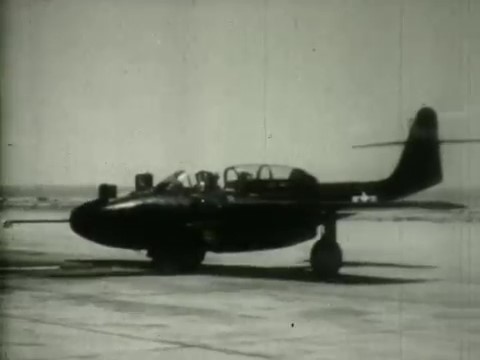The Northrop F-89 Scorpion is perhaps one of the lesser known American jet interceptors of the 1950s. To put the F-89 into some context its development began in 1948, intended to be an all-weather interceptor, its stable mates included the F-86 Sabre and the F-84 Thunderjet. The F-89 made its first flight in August 1948 and entered service two years later.
In August 1945 the US Army Air Force released a specification for a new jet-powered night fighter with a speed of up to 530 mph. Jack Northrop began work on a swept wing design which went on to be evaluated with entries from Bell Aircraft, Consolidated-Vultee, Douglas Aircraft, Goodyear and Curtiss-Wright. The US Army Air Force down-selected Northrop’s design – then known as the N-24 and the Curtiss-Wright XP-87 Blackhawk.

The Curtiss-Wright XP-87 was a slightly larger, slightly heavier aircraft with its two-man crew seated side-by-side. It was powered by two pairs of Westinghouse XJ34-WE-7 turbojet engines mounted on the wings. In comparison the Northrop design was slimmer, with sept wings and had its two Allison J35 turbojet engines buried low in its fuselage to reduce drag.
The N-24 was designated the XP-89 by the US Army Air Force and a full-scale model was ordered. Aerodynamic testing found that the swept wing was unstable in low speed and a straight, narrow profile was developed and the horizontal stabilizer and cockpit configuration was redesigned.
In 1948 the newly formed US Air Force re-designated fighters from P to F and the XP-89 became the XF-89 when prototypes were ordered. During subsequent flight evaluations the XF-89 was found to be faster than the XF-87 and the US Navy’s XF3D (Douglas F3D Skyknight). Evaluators disliked the Northrop and criticised its cockpit layout, however, the USAF moved forward with its development and scrapped the XF-87.

Testing with a second prototype continued and the engines were upgraded with a more powerful Allison J33-A-21 fitted with an afterburner, while concerns about ease of maintenance were answered by having the whole engine capable of lowering out of the fuselage. The XF-89 suffered a number of crashes during testing with a fatal crash on the 22nd February 1950, which killed flight test engineer Arthur Turton when flutter, or vibrations, in the elevator caused the tail of the aircraft to sheer off. The geometry of the rear fuselage and engine exhaust were found to be the cause and were redesigned.

Despite the fatal crash the aircraft’s flaws were addressed and production of the XF-89 was greenlit in January 1949, with a contract for 48 F-89s, worth just over $39 million, awarded in May 1949.
The F-89’s armament varied considerably during its service life. Originally it had been intended for the night fighter to have a turret with four forward-firing cannons and another 2 cannon turret firing aft. This was abandoned and the first F-89As had six forward-firing 20mm cannons and the ability to mount rocket pods carrying 16 5in rockets.

The F-89A was quickly superseded by the B which had the same armaments but improved avionics. The F-89D entered service in October 1954, the D abandoned the cannons and instead had two rocket pods mounting a total of 104 smaller 2.75in ‘Mighty Mouse’ Mk 4/Mk 40 Folding-Fin Aerial Rockets.
Entering service in 1956 the F-89H was equipped with large wingtip pods that could externally carry three GAR-1/2 Falcon missiles each with 21 Mighty Mouse rockets internally. Delays refining the Hughes E-9 fire-control system meant that by the time the H entered service it was outclassed by newer, faster supersonic fighters like the F-100 Super Sabre, F-101 Voodoo and interceptors like the F-102 Delta Dagger and the F-104 Starfighter.

The F-89J, introduced in 1957, refitted the F-89D with underwing hardpoints for two MB-1 Genie nuclear armed rockets and four Falcon missiles. The J could also carry either the standard F-89D rocket/fuel pod or pure fuel tanks. 350 Js were converted from F-89Ds.
An F-89J has the distinction of being the only aircraft to fire a live MB-1 Genie during Operation Plumbbob (nuclear weapons tests) in July 1957. The MB-1 (later the AIR-2) was an air to air rocket with a 6 mile range and a 1.5 kiloton W25 nuclear warhead. It was ostensibly a tactical nuclear weapon designed to take on Soviet strategic bomber formations.
The USAF began to retire the F-89H in 1959 as more supersonic interceptors entered service and the refitted Js also began to be replaced the same year but remained in Air National Guard service for another decade.

The F-89 is definitely a striking aircraft and a substantial number were built, 1,050 in total but they remain one of the lesser known early Cold War jet fighters. The F-89 featured in our video is an H and is on display at the Hill Aerospace Museum.
If you enjoyed the video and this article please consider supporting our work here. We have some great perks available for Patreon Supporters. You can also support us via one-time donations here.
Bibliography:
Military Aircraft of the Cold War, J. Winchester (2012)
Flying American Combat Aircraft: The Cold War, R. Higham (2005)
Early US Jet Fighters: Proposals, Projects and Prototypes, Tony Buttler (2013)
Archival footage and imagery courtesy of the USAF, the US National Archives and the San Diego Air and Space Museum.

2 thoughts on “Northrop F-89 Scorpion”